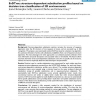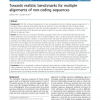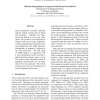259 search results - page 11 / 52 » Accuracy of structure-based sequence alignment of automatic ... |
ACL
2003
13 years 9 months ago
2003
In this paper, we proposed a new supervised word sense disambiguation (WSD) method based on a pairwise alignment technique, which is used generally to measure a similarity between...
BMCBI
2005
13 years 7 months ago
2005
Background: Structure-dependent substitution matrices increase the accuracy of sequence alignments when the 3D structure of one sequence is known, and are successful e.g. in fold ...
BMCBI
2010
13 years 7 months ago
2010
Background: With the continued development of new computational tools for multiple sequence alignment, it is necessary today to develop benchmarks that aid the selection of the mo...
NAACL
2007
13 years 9 months ago
2007
Letter-to-phoneme conversion generally requires aligned training data of letters and phonemes. Typically, the alignments are limited to one-to-one alignments. We present a novel t...
CIKM
2005
Springer
14 years 1 months ago
2005
Springer
In this paper we address the problem of unsupervised Web data extraction. We show that unsupervised Web data extraction becomes feasible when supposing pages that are made up of r...



